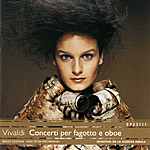With this Volume 22, Opus 111 continues its ambitious project to record more than 450 Vivaldi manuscripts housed in the National University Library at Turin. Like many of the performances in previous installments, these–three bassoon concertos, two for oboe, and one double concerto for oboe and bassoon–also are characterized by widely contrasting tempos, sharply delineated dynamics, and especially here, a stylish in-your-face approach. From bassoonist Sergio Azzolini’s quite audible intake of breath before beginning the Concerto in D minor and continuing throughout this captivating program, rarely have Vivaldi’s wind concertos been rendered with such a consistent sense of urgency, vitality, and well, attitude. At no point do you feel that Azzolini, oboist Hans Peter Westermann, and the members of the Italian period-instrument ensemble Sonatori de la Gioiosa Marca are less than fully engaged in and passionate about their mission to champion this less-familiar though certainly worthy repertoire.
The double concerto for oboe and bassoon in G major is especially ravishing, featuring a first-movement Andante molto where the soloists’ aria-like phrasing sensuously complements the strings, and a spirited final Allegro molto that exploits the combined sonorities of the solo instruments. The opening Allegro from the A minor bassoon concerto (one of Vivaldi’s most recognizable themes), with its measured beat and evolving rhythmic structure, also is rendered with uncommon agility and grace.
Many listeners will be familiar with what arguably is the program’s most famous work, the Concerto for transverse flute subtitled “la Notte” (the night) RV 104. While there have been many exceptional period-instrument flute performances, listeners who enjoyed Giovanni Antonini and Il Giardino Armonico’s groundbreaking, over-the-top extravaganza on Teldec (1991) are immediately directed to this equally animated alternate version. Azzolini’s manual dexterity and breath control, especially in the “Fantasmi” and following Presto movements, are absolutely amazing in what must be three of the most virtuosic displays ever written for the instrument.
Opus 111’s sound is crisp, clear, and naturally balanced, and Azzolini and Louis Vatoison’s informative, entertaining notes feature many fascinating anecdotes. In sum, this is another outstanding entry in an already important and distinguished series that’s guaranteed to delight all fans of the composer.
































